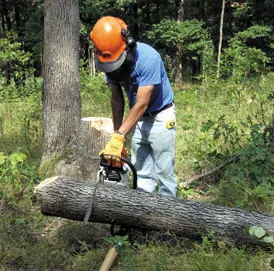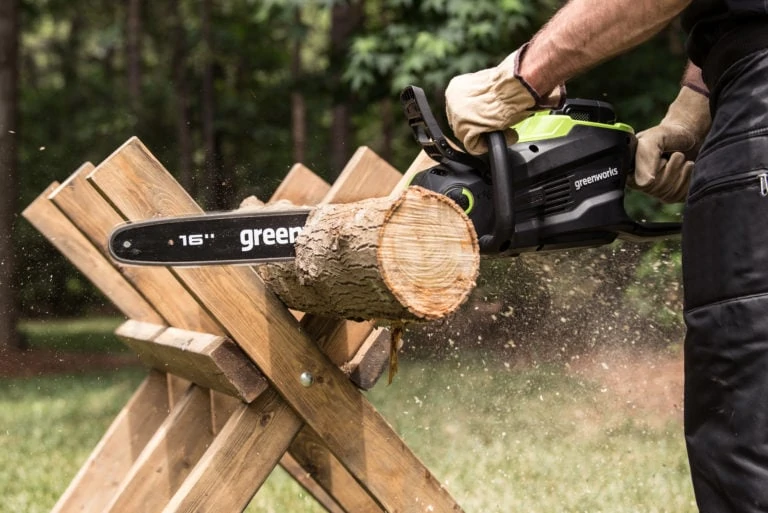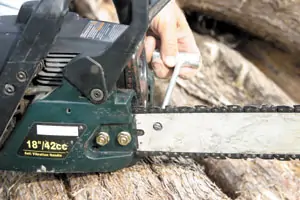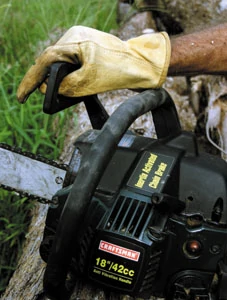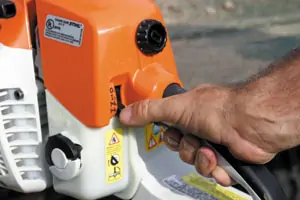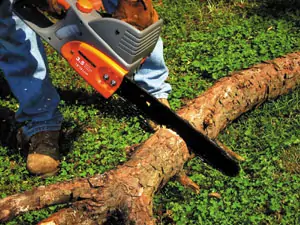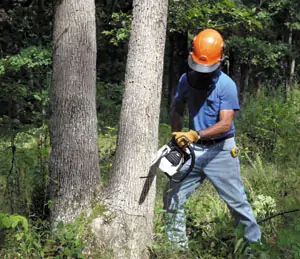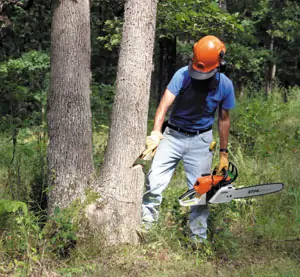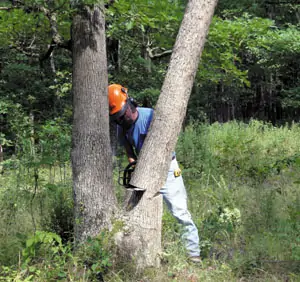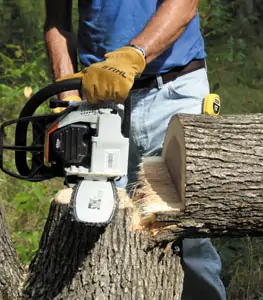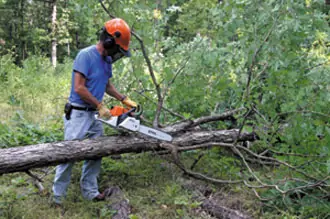Chainsaws — the ultimate tool for some, the ultimate nightmare for others. Chainsaws are actually neither. Once considered the primary tool of professional loggers, ranchers and farmers, chainsaws became a popular homeowner tool when Robert McCulloch introduced the first lightweight model back in the late ’60s. Since that time chainsaws have become increasingly popular with homeowners. Of course, they’re also used by numerous professionals, such as arborists and loggers. Chainsaws can be used around the house for tree pruning, storm cleanup, cutting firewood, felling trees and even creating rough carpentry projects such as fences, fence posts and others.
Chainsaws are available with a wide variety of bar lengths and engine power, including electric- and gasoline-powered models. Before choosing a chainsaw, first consider the uses you will need it for. “Will the saw be used primarily for trimming, felling, cutting or all of those chores?” asks Charlie Durand, manager of sales and training at John Deere Consumer products in Moline, Illinois. Durand also asks how often the saw will be used — regularly, occasionally or extensively.
The saws are basically available in three sizes: mini, mid- and heavy-duty. The mini’s, also called light-duty, range from 30 to 40cc with bar lengths ranging from 12 to 14 inches. Midsize chainsaws range from 40 to 60cc with bar lengths from 16 to 24 inches. Professional, or heavy-duty, saws range from 60 up to 120cc and can have longer bars than most homeowners can fathom. And it requires some muscles to use them. For the most part you should select the saw based not only on engine size, but the diameter of wood you would most often be cutting. With proper use, you can safely cut logs with diameters almost double the length of the bar.
Features
The oiling system is extremely important because oil must lubricate the bar as the chain rides over it. The better the bar is kept lubricated, the longer the chain and bar will last. Oilers are available as automatic, which delivers oil to the bar at a given amount, or automatic/adjustable, which allows you to adjust the amount of oil depending on the job. The Stihl automatic system is designed to reduce oil consumption as much as 50 percent. Both Echo and John Deere offer automatic/adjustable oilers. John Deere Pro models and Echo saws also have a no-oil-at-idle feature, which means you aren’t wasting oil during idling.
Chainsaws take a lot of abuse and they must be used and maintained properly. Keeping proper tension on the chain is important for both safety and efficiency. As the saw runs, it may loosen or tighten. To adjust, most saws have two nuts that must be removed or loosened. A large tension screw located behind the bar is then used to maintain proper tension. You’ll need the appropriate wrench and screwdriver. A number of saws these days, including Craftsman, Poulan, and some Husqvarna and Echo models have the adjustment on the bar itself, a much easier method than having to locate and adjust the tension screw. Stihl has a side-access chain tensioner on some models that allows you to adjust through the sprocket cover. Some Stihl models feature an exclusive “no-tools-required” Quick Chain Adjuster. To adjust the tension, simply loosen a dial on the side, adjust the tension by turning a top-mounted knob, and then retighten the side dial.
Maintaining chain tension is extremely important. Some modern saws have an easier means of adjusting the tension than older models.
Many modern-day chainsaws also offer numerous safety features older saws didn’t have. When shopping, look for these features: A chain guard will catch the chain should it slip off during operation. Hand guards prevent accidentally touching the moving chain should your hand slip off the handle. A rear hand guard also protects your hand if the chain happens to come off the bar. A safety interlock feature is found on some saws. The interlock utilizes two triggers on the handle to prevent accidental operation of the throttle. If you don’t hold the throttle lock-out in place with your hand, the saw won’t start or run.
The most dangerous occurrence in chainsaw use is kickback, a reaction that happens when the moving chain near the upper quadrant of the nose contacts a solid object. The action of the chain’s cutting force creates a rotational pull on the saw in the direction opposite the movement of the chain. The force created can fling the bar up and back in an uncontrollable arc, mainly in the plane of the bar. This moves the bar back toward the operator and can cause severe injury.
Chain brakes are the first step in preventing kickback. Chain brakes are available as two types: manual and inertia. Manual chain brakes must be activated by hand. Inertia chain brakes are the safest because they operate from the force of the saw being thrown backwards, or they can also be hand-activated if needed. Inertia brakes are found on most recent models from John Deere, Echo, Makita, Jonsered, Homelite, Husqvarna, Shindaiwa, Tanaka and Craftsman. Stihl was the first to offer a chain brake. Some of their models have two-way and some have three-way chain brakes. They are activated by inertia, by the hand guard, and also with the interlock lever.
A chain brake is an important safety feature. Some are mechanical, some are inertia-operated and some saws offer both.
Some consumer saws offer a safety tip on the end of the bar to prevent insertion of the bar end into a cut, also protecting against kickback. Most nonprofessional saws also are available with low kickback chains. These chains can reduce kickback by as much as 75 percent as compared to a non-kickback chain.
Additional Features
Those of us who used chainsaws 25 years ago really appreciate the ease of starting and handling today’s saws. Purge-pump-equipped carburetors are found on many saws. This extends starter life by limiting the number of pulls needed to start the engine. Most will start on the first or second pull when gasoline is pumped into the carburetor before starting. The larger saws from John Deere, Stihl, Jonsered and Husqvarna also feature decompression valves. These reduce the pressure needed to pull the starter rope. Stihl, Jonsered and Husqvarna saws also feature a single-start control that simplifies cold starting and prevents flooding. Most of today’s saws also feature some sort of vibration isolation. These vibration isolators or dampening systems reduce operator fatigue and also help the chainsaw to last longer. Today’s saws also feature easy-to-use and conveniently located controls. Stihl features one switch that does it all — on/off, choke and fast-start.
Easy starting is a great feature of today’s saws. Devices such as a single-start control simplify cold-starting and prevent flooding.
Electric Saws
If your homeowner chores consist mainly of trimming trees around the home, casual pruning or other light duties, an electric saw may be your best bet. Although less powerful than gas-powered models, the electric saws are much quieter and lighter weight. Available from companies such as DESA Specialty Products (Remington), Black and Decker, and Makita, these saws don’t produce fumes. In most instances, you are tied to an electric cord, and the cord must be heavy enough to cover the proper amount of current. A cord that is too light can cause the saw to overheat. Makita, however, has a cordless model.
Electric chainsaws, such as the Remington from DESA Specialty Products, can offer up to 3.5 horsepower. Electric models start quickly, run quitely and eliminate the need to mix oil and gas.
How To Use
Today’s chainsaws are relatively easy to use and extremely efficient. They can also be extremely dangerous. According to the Consumer Products Safety Commission, each year nearly 100,000 injuries occur involving a chainsaw. These injuries can be drastically reduced with proper safety training and a little advice from the experts. According to Tim Ard, president of Forest Applications Training, Inc., and instructor and co-founder of The Game of Logging, the chainsaw has been deemed as one of the most hazardous tools in the workplace where tree removal, repair and storm cleanup work is performed. As a 25-year veteran of the outdoor power equipment industry, Ard instructs almost 7,000 people annually in chainsaw safety and application throughout the United States. He feels most users are unaware of the potential uses and dangers of chainsaw operation and suggests these six safety tips:
1. Select the right size saw. A midsize saw is right for cutting wood on the ground. One with a bar of 16 to 20 inches offers good maneuverability without being too heavy. For smaller limbs and chores, a light-weight, high-speed saw is recommended.
2. Above all, wear appropriate protective gear. By far, the most overlooked aspect of tree-felling safety is proper apparel, without which no felling job should be undertaken. A properly outfitted operator should wear protective chaps or rugged pants, eye and ear protection, protective footwear, work gloves and helmets. Always avoid loose-fitting clothing.
3. Inspect the saw before use. Ensure the chain brake is clean, that the brake band isn’t worn, and that both the inertia and manual activation of the chain brake are in proper working condition. The chain should be sharpened and should exhibit proper tension.
4. Start safe. A chainsaw is safest to start on the ground. Be sure nothing is obstructing the guide bar and chain. To make sure the saw sits securely on the ground, place your right foot in the rear handle.
5. Carefully plan your cutting job. Avoid hazards such as dead limbs, electric lines, roads and bystanders (work at a safe distance, but never work alone). Evaluate wind direction and the lean of the tree.
6. Protect yourself against kickback. Never modify or remove the chain brake. It is designed to reduce the effect of kickback and prevent possible injury.
Above all else, make sure you read and understand the user information from your saw manufacturer’s instruction manual before using the saw.
Basic Chores
Chainsaws are commonly used for several specific woodcutting chores. I’ve also used an electric chainsaw for butchering beef, and my dad used a small chainsaw to cut ice from his pond in the winter to water the livestock. I’ve also used a chainsaw to rough-cut framing for remodeling chores. Most uses include pruning or trimming trees, felling trees, limbing or cutting limbs off felled trees, and bucking or cutting trees or limbs into desired lengths. The latter can be for firewood, saw logs or in the case of storm damaged trees, sometimes simply to make the pieces small enough to haul away. When pruning, trimming or limbing, do not reach above chest height, and don’t reach far out to make cuts, especially on ladders. When on the ground, regardless of the chore, make sure to maintain a safe, stable stance.
Always inspect the chain. A dull chain is hard on both you and the saw. It can cause you to apply pressure, which is dangerous and bad for the chain. With proper tension, the chain should not move while the saw is idling.
Fuel or refuel the saw in a safe place on bare ground where nothing is burnable, then move the saw to another location before starting. Place one foot in the rear handle guard, making sure nothing obstructs the chain and that the chain is not touching the ground, and then start the saw.
Felling a tree is considered the most difficult and dangerous task by many, and indeed it can be. The first step is to examine the tree to determine the direction of lean, if any. If in doubt, use a string line and plumb bob to see if the tree has any lean. Also examine the crown. Does one side have more or larger limbs? Then determine the wind direction. All of these factors have an influence on where and how the tree will fall. If at all possible, fell the tree with its natural lean. Examine for other problems — nearby buildings, other trees, power lines or any other obstacles. Clear the ground around the tree of all obstacles and make at least two escape paths with no obstacles that could trip you. Make sure all pets and people are kept away from the tree during cutting, but do not cut alone.
The moste common method of felling a tree is with a notch and hinge.
The most common method of felling is with a notch and hinge. Cut a notch about two-thirds through the trunk on the side of the tree facing the desired direction of fall. First make a cut parallel to the ground, then a slanting cut downward to meet the first cut. Remove the wedge to create the notch. From the back of the tree, make another cut parallel to the ground and about 2 inches above the notch cut. Do not cut all the way through. Instead, leave a section of wood to act as a hinge. This will help guide the fall of the tree and also prevent it from kicking back and upward when the limbs strike the ground.
Never stand directly behind a tree being felled. As it falls, the tree butt can kick back with enough force to kill you. Watch the tree and as soon as it begins to lean, remove the saw, shut it off and get away as quickly as possible. If necessary, leave the saw. If the tree leans a bit but doesn’t fall, make a slightly deeper cut from the back, but do not cut through the hinge. If the tree doesn’t fall, use plastic or wooden wedges driven into the back cut to start it falling.
Limbing or cutting the limbs from the trunk is the next step. Plan your cuts so the limbs don’t bind and pinch the saw blade, cutting from either the top or bottom of the limbs as needed. Cut from the opposite side of the tree if possible. Be careful that the tree doesn’t roll over on you. Start with the crown and the upper limbs if possible. If they are too high off the ground, cut them off at trunk-level first.
Bucking or cutting the limbs or trunks into lengths is the next step. Again, plan your cuts from either the top or bottom side to prevent the downward pressure of the cut limbs from binding the saw blade. Do not allow the saw chain to touch the ground. Cut almost all the way through, roll the log with a cant hook and finish the cuts. Or use a Timberjack, such as that from Woodcraft Supply. It rolls the log end up and off the ground for easy cutting. Or, you can place short lengths of logs under the log to be cut. You can also use a sawbuck to cut small-diameter logs into firewood.
With a little education, practice and safe use, you may find a chainsaw a very valuable homeowner tool with a number of handy uses.
